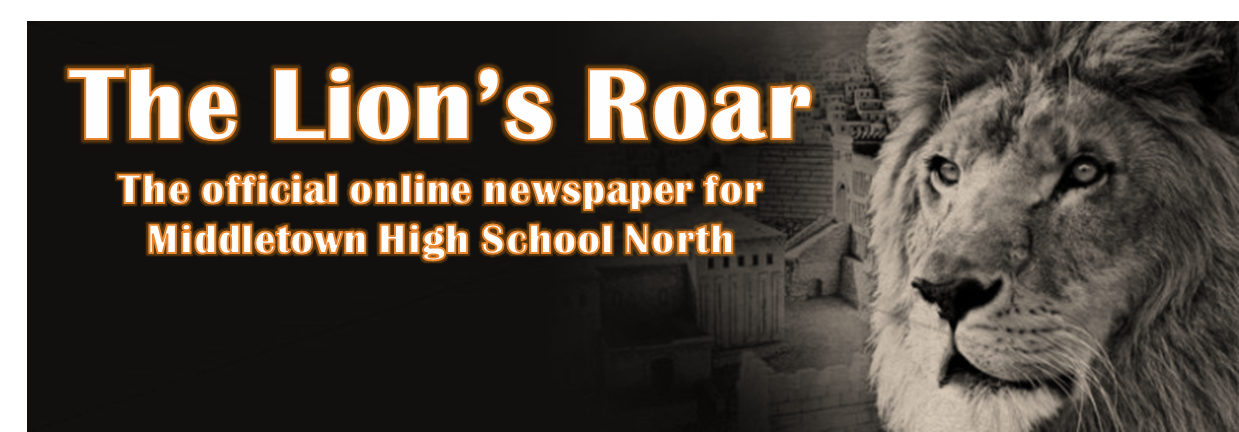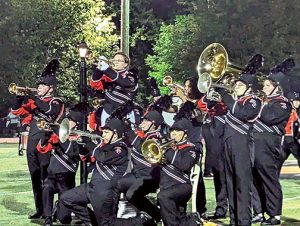Original Story Posted via The Two River Times
Here’s to All the Lions
Here’s to all the Lions, Strongest of all.
Here’s to our team, boys
May we never fall!
Rah! Rah! Rah!
Here’s to all the fellows,
Where ‘ere they be,
Shouting the battle cry of victory!
Here’s to all the Lions,
Dearest and best,
For them we’ll strive boys,
Work with pride and zest!
Rah! Rah! Rah!
Through the years that follow,
Faithful we’ll be,
Shouting the battle cry of victory!
Rah! Rah! Rah!
Perhaps the most recognizable high school fight song at the Jersey Shore is the one the Middletown High School North Orange Wave marching band plays after every touchdown. Whereas most schools have taken their fight song music from the college level, the Lions have been playing and singing original lyrics to “Here’s to All the Lions” for nearly 100 years.
Fight songs have been around as long as there has been football. Music was written to get students more excited and involved in the game. The University of Michigan first introduced “Victory” in 1898. The “Notre Dame Victory March,” Navy’s “Anchors Aweigh” and “On Wisconsin” all came about in 1909. Yale University’s “Down the Field” is often considered the most famous fight song ever.
The story behind the fight song at Leonardo High School, as the Middletown Township school was affectionately known until 1966, has its own fascinating story.
When it came to the small agricultural high school located in the Leonardo section of Middletown, the origins of the school fight song coincided with the 1923 hiring of a new physics and biology teacher, Lewis “Gyp” Blood. He was asked to coach the football, basketball and baseball teams. Known as the “Father of Football in Middletown,” Blood directed the Leonardo High School team to gridiron state titles in 1925 and 1926 and led the baseball teams to state championships in 1926 and 1928.
Blood’s son, Charles “Chick” Blood, shared the background of how his father came to Middletown. Lewis was born in Willimantic, Maine. In addition to his teaching and coaching expertise, he had an excellent background in music. He attended Foxcroft Academy in Dover, Maine, where he studied music and played in the band. Upon entering the University of Maine, Lewis played some football for the Black Bears but also was a member of the campus National Guard Band. In 1916, when the United States sent troops to quell Pancho Villa and his revolutionary army in Mexico, Lewis was in charge of the military band under legendary U.S. Gen. John “Black Jack” Pershing. During World War I, his background in chemistry led to his involvement with the testing of gas masks. Legend has it that Gyp was not afraid to test out a new gas mask by entering a room filled with gas.
When he arrived at Leonardo High School in the fall of 1923, he was immediately impressed with the school spirit and sportsmanship demonstrated by the student body. However, he realized the school was lacking a formal band and subsequently formed the first ensemble. Being familiar with fight songs at the college level, Lewis felt it only appropriate that the school have its own anthem to match the school spirit. He modeled the song after a well-known Harvard fight song, “Our Director,” which was written by the nationally renowned composer Frederick E. Bigelow. Blood adapted the score and lyrics to be more suitable for a high school football team. The result is a song with a joyful and brisk melody. Undoubtedly, he envisioned the march to be played at pep rallies and football games.
Legend has it that Bigelow, while attending Worcester (Mass.) Academy in the late 1880s, wrote this march in his spare time while sitting at his kitchen table. He intended it to be played by a brass band. That was the beginning of the march’s fame. Around the turn of the century, it was appropriated as a fight song for Harvard football games and was soon picked up by other colleges, clubs and organizations as their alma mater or fight song.
In the version of the march that Blood created, the first line was, “Here’s to old Leonardo,” in honor of the name of the high school at the time. Older alumni today still sing the song in this manner.
In the early 1950s, sports reporters started referring to the school as Middletown Township High School. The name of the fight song was subsequently changed to “Here’s to All the Lions.” It has retained this title for nearly 70 years.
When Bigelow wrote the music, the first part of the march had a different and more dramatic tone. Lewis dropped that portion of the song to create a fight song that was personalized for Leonardo High. The original song was played at a much slower pace, similar to an alma mater. When the current band plays the song after a touchdown, it has a much faster and peppier beat. It is believed the only other school in the Shore Conference that has an original fight song is Toms River South High School’s “Old Indian Tom.” When Mater Dei High School of Middletown was founded in 1963, they created a school song called “Mater Dei, Blue and White… Fight, Fight, Fight” but with the closure of the school in 2022, it is no longer heard.
Beth Lyon, a music teacher at Middletown High School North, has been the director of bands at the school on Tindall Road since 2009. She is also responsible for all instrumental ensembles, along with the concert band, the Orange Wave marching band, the pep band and UpRoar, the jazz band. A graduate of William Paterson University, where she majored in music education, Lyon takes great pride in continuing a tradition that was started by Lewis Blood a century ago. She truly enjoys the feeling whenever the Orange Wave plays “Here’s to All the Lions.” Alumni and fans all know the words and join in and sing the lyrics that celebrate the Orange and Black.
Ray Veth is a 1970 graduate of Middletown Township High School. He was a member of the Lions football, baseball and wrestling teams when there was only one public high school in town. A member of the Monmouth County Genealogy Society and the Middletown Township Historical Society, he has always taken a special interest in local sports history. For more information or to share old sports photos or stories, he may be reached at [email protected].
The article originally appeared in the September 19 – 25, 2024 print edition of The Two River Times.

